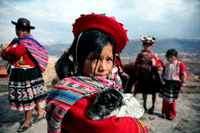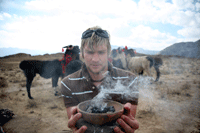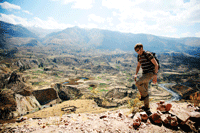- Details
- Written by: David
Crouching here precariously, on the edge of a massive canyon, I have a grandstand view of one of the most magnificent spectacles in the natural world. My lungs feel as if they’re about to burst through my chest wall after five hours of relentless climbing, but frankly, I don’t care – this sight is worth every step of the thigh-burning, ankle-turning schlep.
A few metres away, a young condor is sunning itself on a rock, a gentle breeze ruffling its chocolate-brown feathers. For the group of Peruvian guides I’ve been trekking with, the condor – the largest flying land bird in the western hemisphere – is a symbol of good luck. For me, it’s mission accomplished. I have to admit, I am a little bit of a bird geek, and fascinated by birds of prey.
The last three days have been spent hunting high and low, hiking up to altitudes of 4,000 metres, in search of these elusive birds. While many guides will guarantee you a glimpse of the condors, most of the time that’s precisely all you’ll get: an obscure black speck in an expanse of electric-blue sky. To see a wild one on the ground is a rare privilege, requiring patience, commitment and lungs of steel.
My avian pilgrimage began at a tiny splodge on the map, called Cabanaconde. Located in the south of Peru, this titchy village is about as far off the beaten track as you can go. Getting here involved a 17-hour flight from London to Lima, via Amsterdam, before taking two internal connections: an hour’s flight from Lima to Cuzco and another plane a short 45-minute hop from Cuzco to Arequipa. And, just to make sure I’d really given the tourists the slip, the last leg was a five-hour, bone-shaking minibus ride.
Cabanaconde marked the start of a three-day hike that would see me descend nearly 3,500 metres into the basin of the Colca Canyon, before climbing out on the other side – where I’d eventually meet my feathered friends. Reputed to be the second largest in the world, the Colca makes the Grand Canyon look like Cheddar Gorge. Unlike the Inca Trail, which has become increasingly crowded in recent years, you won’t find bus-loads of tourists cluttering up the pathways here.
Looking across the top of the canyon completely alters your perspective on life, the universe and everything. On the opposite side of the basin I spotted ancient green terraces cut out of the hilleside, forming a giant’s staircase down to the river below. They were built by the Collagua and Cabana people, who settled here from the ninth century onwards. Today’s villagers still grow their crops using much the same methods as their ancestors.
A tap on the shoulder from my Peruvian guide, Wilson, brought an end to any further daydreaming. Between our small group – Julian (an avid photographer), Wilson, another guide, Sebastian, and me – and the condors, lay some of the toughest terrain I’ve ever encountered. I found it harder than trekking in the snow more than 4,000 metres up in the Himalayas – you really have to concentrate on the rocky terrain or you might twist an ankle. Although the hike itself was probably only 32km long, it was the amount of vertical that I was worried about – nearly two kilometres descent on the first day alone. Over the following two days I would have to do exactly the same again – only uphill.
Continued...
 After gawping at the view for what seemed like ages, Wilson announced that it was time to ‘Vamos’. Before lacing up our walking boots, however, we had to perform a series of rituals to guarantee our safe return. I’m not sure exactly what it all signified; only that it involved burning incense, drinking lots of home-brewed liquor and throwing any leftovers at a herd of llamas who were becoming increasingly irritated. They were here to carry our kit (begrudgingly). Suitably ‘blessed’, Wilson and Sebastian loaded up the llamas before we began the descent to the base of the canyon – four hours’ walk under a searing hot sun. When you’re hiking at an altitude that’s akin to the summit of Mont Blanc, each step requires enormous effort.
After gawping at the view for what seemed like ages, Wilson announced that it was time to ‘Vamos’. Before lacing up our walking boots, however, we had to perform a series of rituals to guarantee our safe return. I’m not sure exactly what it all signified; only that it involved burning incense, drinking lots of home-brewed liquor and throwing any leftovers at a herd of llamas who were becoming increasingly irritated. They were here to carry our kit (begrudgingly). Suitably ‘blessed’, Wilson and Sebastian loaded up the llamas before we began the descent to the base of the canyon – four hours’ walk under a searing hot sun. When you’re hiking at an altitude that’s akin to the summit of Mont Blanc, each step requires enormous effort.
Turning an ankle was the least of my concerns, though: slip over here and you’ll end up in a tragic YouTube video (‘Base-jumper forgets parachute’).
As we descended ever further, I began to grasp the canyon’s sheer size. It was enormous: four miles across at some points. Out here there are no mobile phone calls – just the ubiquitous sound of our trudging feet, and the tinkling of bells attached to the llamas.
These animals have clear human traits. Not only do they have a tendency to spit at you if they get annoyed, but they constantly chatter to each other in tones that sound like a balloon being deflated. I had to keep reminding myself that there were no blokes inside working them, pantomime-style.
Having spent the day in the full glare of the Peruvian sun, we arrived at a veritable oasis on the valley floor and set up camp among the trees. My legs had turned to jelly from the hours spent walking downhill, but this was nothing compared to what the next few days held in store.
A 4am shove from Wilson heralded the start of a new day. Less than an hour later we were beginning a five-hour hike up the opposite side of the canyon. Every twist and turn of the path revealed a sight that took my breath away – no doubt aided by the scarcity of the oxygen. Parched peaks stretched up into the sky like jagged teeth. Flocks of bright green parakeets flitted about overhead, disturbed by the clinking of the llamas’ bells.
Finally, with the first rays of sun arriving to bathe the canyon in a warm, golden glow, I caught sight of something that made all the effort worthwhile. Perched on a rocky outcrop to our left, a young condor sat sunning itself. Early mornings are the best time to see these magnificent birds, which weigh around 15 kg, with a wingspan of up to three metres.
Continued...
 Crouched low, thighs on fire, I try to keep quiet. Apart from the sound of the wind whistling up the valley, it’s totally silent; I can hear the blood coursing through my system. Finally, the condor takes to the air. There’s no ceremony, it simply lifts its wings and launches itself into thin air as if wading into water.
Crouched low, thighs on fire, I try to keep quiet. Apart from the sound of the wind whistling up the valley, it’s totally silent; I can hear the blood coursing through my system. Finally, the condor takes to the air. There’s no ceremony, it simply lifts its wings and launches itself into thin air as if wading into water.
I watch it glide out over the canyon, wingtips outstretched like fingers, before catching a thermal and rising up towards the sun. Against a cloudless blue sky, it forms the iconic silhouette that I’ve only ever seen in wildlife films before today.
Suddenly, it banks round and heads back towards us. For a moment I think it’s going to swoop down and grab me, like Tintin, but it’s just curious. As it soars straight over my head, I feel its draught ruffle my hair. If I raised my arm now, I’d be able to touch it.
This is fantasy land for twitchers – something bird watchers only dream about. I’ll be aching for the next week, but it has been worth every step.
FIVE OTHER GREAT TREKS
The Annapurna Circuit, Nepal
Journey to the top of the world, via rugged peaks and lush green gorges. The route up is littered with teashops and restaurants, making it easy to find your way without a guide. For something more challenging, try the hike to Rara Lake – the biggest in Nepal.
More info: www.explore.co.uk
Mount Kenya, Kenya
Take some of the most stunning views you’ll ever see, and throw in exotic wildlife like monkeys, rhino, buffalo, and even the odd lion if you’re lucky. Thousands of years of volcanic activity have created amazing rock formations at the top.The summit is 5,199 metres.
More info: www.rainbowtours.co.uk
Jungfrau region, Switzerland
Don’t forget the awesome hiking that’s closer to home. The Jungfrau itself is littered with ancient paths formed by the generations of shepherds. They lead to the most spectacular views of valleys so green that they look like they’ve been coloured in with felt-tip pen.
More info: www.inghams.co.uk
The High Sierras, California, USA
You could hike here for two weeks without going anywhere near a road. One of the most beautiful climbs is Mount Lassen in the north, which takes you through a labyrinth of gargantuan pine trees, where the smell of wild flowers wafts across the valley. The 600-metre volcanic peak, which is still active, is one of the largest lava domes on earth.
More info: www.trekamerica.com
Basingthang Valley, Bhutan
In a country that opened up to foreigners less than 30 years ago, you know you’re in for something unusual. The route takes you up through the Himalayan foothills, along yak trails, to the Tibetan border at well over 4,000 metres.
More info: www.footlooseadventure.co.uk
In the know
Matt Carroll travelled with RealPeru.
visit: www.therealperu.co.uk
A variety of international flight options is available from most UK airports
For more information about Peru please visit PromPeru’s website:
www.peru.info
Travelling somewhere with amazing scenary? Read our Photography tips here!
Photographs: Julian Hanton




